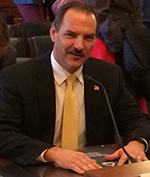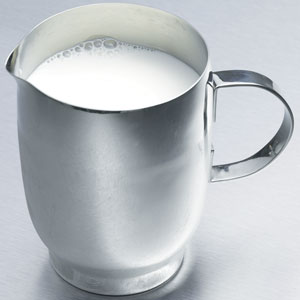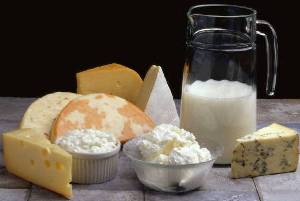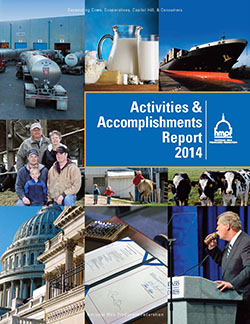 Mid-March and early April were active periods for NMPF on the trade front.
Mid-March and early April were active periods for NMPF on the trade front.
On March 18, Wisconsin dairy farmer and NMPF Board member Pete Kappelman testified on Capitol Hill about the need for favorable free trade agreements to sustain dairy export growth. The next day, NMPF joined major national and international dairy groups in stressing the importance of achieving favorable dairy market access in the Trans-Pacific Partnership.
Two weeks later, on April 2, NMPF joined the International Dairy Food Association and the U.S. Dairy Export Council in praising more than 75 House members who urged the Obama Administration to negotiate a strong market-access outcome for the U.S. dairy industry in the Pacific Rim trade agreement. The letter highlighted the need for a positive dairy result.
As head of NMPF’s International Trade Committee, Kappelman represented the federation at the mid-March House Agriculture Committee hearing on the importance of trade to agriculture. He noted that since 2000, U.S. dairy exports have increased 625 percent – to a record $7.1 billion – and that exports are now “critical to the health of my farm and our dairy industry at large.”
Kappelman, who is chairman of Land O’Lakes and a NMPF board member, said it is not a coincidence that this export growth occurred while the United States was implementing several free trade agreements, and that each of those was approved using Trade Promotion Authority.
Kappelman urged Congress to approve new TPA legislation in order to facilitate a favorable Trans-Pacific trade agreement. The TPA legislation is expected to be introduced in Congress next week. “Significant access to TPP’s most protected dairy markets – Japan and Canada – is absolutely essential to us, and both of those countries have pointed to the importance of having TPA in place as TPP talks enter their final stage,” he said.
A day after Kappelman’s testimony, NMPF joined USDEC, IDFA, and national dairy organizations of Australia and New Zealand in pressing trade and agriculture officials of all three countries for “significantly increased dairy market access” with Japan and Canada in the Trans-Pacific Partnership negotiations.
In a joint letter, the organizations said TPP offered a historic opportunity to eliminate trade distortions and that access to the Japanese and Canadian markets should not be hindered by non-tariff barriers such as the European Union’s aggressive stance on geographical indications.
Earlier this week, NMPF, USDEC, and IDFA commended 75 House members for advising U.S. Trade Representative Michael Froman and Agriculture Secretary Tom Vilsack that “winning an overall positive market access result for the U.S. dairy industry is critical to the success of the TPP negotiations.”
The dairy groups said that dairy producers and processors agree on the importance of a balanced, positive TPP outcome for their industry and that Canadian and Japanese dairy market barriers must be addressed in any final TPP agreement.

 NMPF thanked West Virginia Governor Earl Ray Tomblin for vetoing legislation April 2 that would have allowed consumers in that state to obtain unpasteurized milk through herd-shares. NMPF urged a veto of SB 30 in a joint letter with the International Dairy Foods Association in March.
NMPF thanked West Virginia Governor Earl Ray Tomblin for vetoing legislation April 2 that would have allowed consumers in that state to obtain unpasteurized milk through herd-shares. NMPF urged a veto of SB 30 in a joint letter with the International Dairy Foods Association in March. NMPF has urged the Departments of Agriculture and Health and Human Services to continue recommending at least three servings of dairy a day as part of the 2015 Dietary Guidelines for Americans.
NMPF has urged the Departments of Agriculture and Health and Human Services to continue recommending at least three servings of dairy a day as part of the 2015 Dietary Guidelines for Americans. In March,
In March,  NMPF’s latest Activities and Accomplishments Report is available on the organization’s website. Published annually, the report is an account of NMPF’s actions and achievements on all the issues it faced in the previous year.
NMPF’s latest Activities and Accomplishments Report is available on the organization’s website. Published annually, the report is an account of NMPF’s actions and achievements on all the issues it faced in the previous year. The joint
The joint  The Animal Agriculture Alliance will hold its 2015 Stakeholders Summit in Kansas City on Wednesday and Thursday, May 6-7. Dairy producers interested in attending can register through the organization’s website.
The Animal Agriculture Alliance will hold its 2015 Stakeholders Summit in Kansas City on Wednesday and Thursday, May 6-7. Dairy producers interested in attending can register through the organization’s website. The dairy industry today praised the more than 75 House members who have urged the Obama Administration to negotiate a strong market-access outcome for the U.S. dairy
The dairy industry today praised the more than 75 House members who have urged the Obama Administration to negotiate a strong market-access outcome for the U.S. dairy  Legislation Will Establish Labeling Guidelines to Help Farmers and Consumers
Legislation Will Establish Labeling Guidelines to Help Farmers and Consumers



